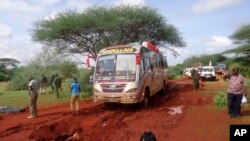Pushed out of its former strongholds, militant group al-Shabab has been moving lots of men and equipment into southern Somalia, especially Lower Juba and Gedo, the two regions that border Kenya. Analysts say this is one area where the Islamist group can still project its power and put pressure on authorities.
In the early hours of Tuesday, heavily armed al-Shabab militants entered tents in a village just outside of Mandera, Kenya and killed 36 quarry workers. Ten days earlier, the group executed 28 people in nearby Arabia village.
The attacks led Kenyan President Uhuru Kenyatta to replace his interior minister and accept a retirement request from Kenya's police chief.
Proximity, access
So how is a Somali militant group able to move so easily within Kenya and carry out such deadly attacks with little interference from security forces?
Robleh Garaad, a local journalist and a resident in the northeast, said the area's proximity to Somalia helps al-Shabab carry out its attacks.
First, he said, the area targeted is not that far from the border with Somalia. He also said the people who are planning or executing these attacks are not coming from a distance, they are inside the country, they are part of the community, and they live in Mandera. He said planning and carrying out these kinds of attacks is not taking them a massive amount of time.
Al-Shabab has been laying the groundwork for its operations inside Kenya for years, according to Cedric Barnes, the Horn of Africa project director of the International Crisis Group.
“First being the result of a longstanding recruitment and radicalization in parts of Kenya, including northeastern Kenya, over a long period that has taken people into Somalia and trained as jihadists and then redeploy them into Kenya or push them across the border from Somalia," said Barnes.
Barnes said lack of coordination between Kenya's new county governments and the central government also has weakened the security response.
Ironically, the success of African Union peacekeepers in pushing al-Shabab from Somalia's major cities also may be contributing to the spate of attacks along the border. The militants have regrouped in southern Somalia, and are taking advantage of the porous Kenya-Somalia border to make attacks that show the group still has strength.
Escalating violence
In 2011, Kenya sent troops into Somalia following a string of suspected al-Shabab attacks on foreign tourists and aid workers in coastal and northeast Kenya. Since then, Kenya has merged its forces with AU forces in Somalia, but al-Shabab attacks in Kenya have increased dramatically.
Last year’s attack on Nairobi's Westgate shopping mall killed more than 70 people and was followed by several deadly attacks in the town of Mpeketoni.
Local Kenyans have been very critical of the government. Some politicians even have called for the withdrawal of troops from Somalia.
Garaad echoed some of the sentiments in the northeast and the rest of Kenya.
"The feeling among the intellectuals and politicians is that a complete security revamp is needed," he said. "Ethiopia has a border with Somalia and was involved in fighting al-Shabab, the previous government and the Islamic courts, yet Al-Shabab doesn’t dare to attack, so there is something missing that Kenya is not doing right, some techniques are missing. Kenya got involved in a mission beyond its capability, and troops are not seasoned enough."
So far, Kenya has shown no sign of backing down from the fight against al-Shabab. However, the security shakeup indicates the Kenyan government is beginning to listen to the complaints of its people.








